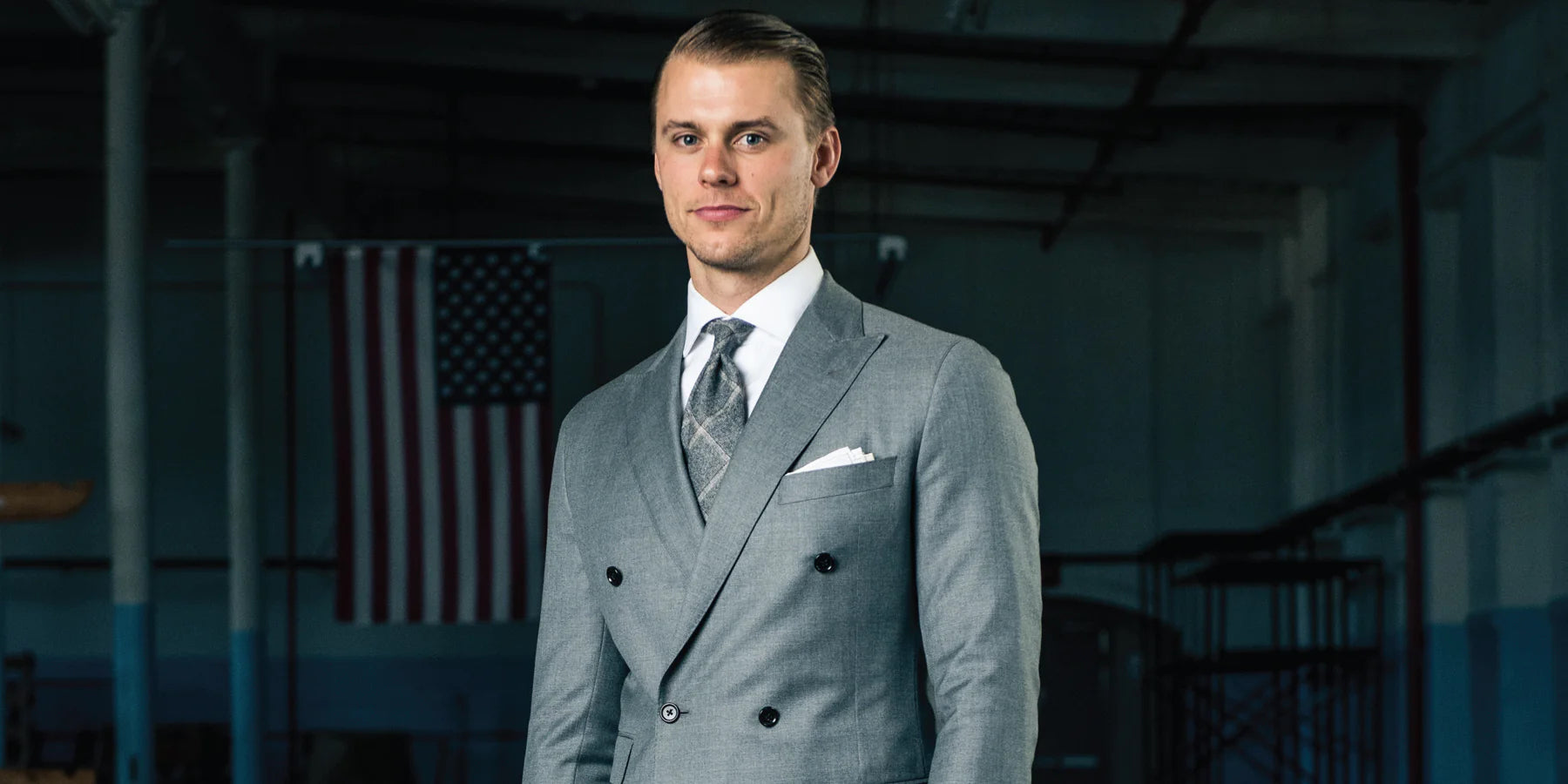Buying a piece of clothing that doesn’t fit is very frustrating, a huge waste of time and money, and terrible for the environment.
You won’t wear it, and you will eventually have to replace it.
So we created the “How It Should Fit” series to you help you look and feel great, save you time and money, and help save the planet from overconsumption.
In this edition, we take closer look at the double-breasted jacket.
Here’s how it should fit.
WHAT IS A GOOD FIT?
A proper fitting garment flatters the body by contouring its natural lines. The garment should be cut as close to the body as possible without causing any pulling, wrinkling or stress areas on the fabric. You’re looking for a clean drape that showcases and enhances the natural form of the body. The fitting of a double-breasted jacket should follow the same rules as the single-breasted jacket.
SHOULDERS
The shoulder lines of the jacket should correspond with your natural shoulder width. Beyond the shoulder seam the sleeve line should move downward immediately, not protrude outward beyond the seam (this is too small). Alternatively, there should be no “hang-time” or “lip” of the shoulder pad protruding over the arm line (this is too big). Traditionally, a DB, which is considered more formal than a single breasted jacket, was built with a structured shoulder and a slightly roping. Today, however, they come in all shapes and sizes, including our favorite, the “natural” unpadded shoulder.
COLLAR
The jacket collar should hug the shirt collar all the way around the neck, with no gapping. There should be about about 1/2″-3/4″ of shirt collar showing above the back of the jacket, with a smooth upper back (no collar roll). With ideal proportions, the shirt collar points should also be neatly tucked under the jacket lapels.
CHEST
The front chest should be clean and neat. If the jacket is too large in the chest there will be a “pooling” or “lump” of extra fabric sitting in front of the armholes. If the chest is too small, the lapels will pull open and not lay flat, and there will likely be pulling/wrinkling in the sleeves beginning from the bottom of the armholes.
LENGTH
A double-breasted jacket should be slightly longer than a single-breasted to avoid looking “boxy” and stretch the silhouette. The back panel of the jacket should drop slightly below the bottom of the seat, and the front should just pass the crotch line of the trousers. As far as front/back balance, the jacket should be perfectly parallel and level to the ground (not “hiked up” in the front or back).
STOMACH
This is an important part of the cut of a double-breasted jacket. I find that many DBs have too much allowance in the midsection, causing them to look boxy rather than flatter the physique. The midsection of the jacket should be as trim as possible without causing any pulling at the button – you should be getting the same “slimming” effects as a slim fit single-breasted jacket. The button stance is the narrowest part of the jacket, and therefore should be aligned with the smallest part of your torso for maximum suppression.
BUTTONING
Speaking of the button stance, just as you would leave the bottom button of a single-breasted jacket open, you should also leave the bottom button of a DB unfastened, this gives a stuffy look a little nonchalance and allows the fabric to drape freely. With that said, one button that should always remain fastened is the interior stomach button which holds the underside front panel in place (so it doesn’t droop down at the hemline). This button can be a little tricky to fasten, just remember than the button itself should be laying flat against your stomach.
HIPS
At the bottom of the jacket, you’re looking for full coverage, with the vents laying straight and flat. Too small and the vents will pull open, too large and the the hem of the jacket will “flare” or “wave”. The lines of the jacket should point straight down to the floor, not flare out at an angle.
BUTTONS
There are several types of double-breasted jackets. They are denoted like this: “total number of buttons on the front” x “number of buttons that fasten”. For example, the jacket in this article is a 6×2 (the most common and traditional). Also popular is the 4×2 (no nipple buttons). The major difference of a 6×1, 4×1, or 2×1 is that, since only one button fastens, the button stance is lower. This creates a longer lapel line which can sometimes be harder for a tailor to cut so that it lays flat all the way up and over the chest.
SLEEVE
A trim sleeve can make a huge difference in the appearance of the jacket. The sleeve should be as trim as possible without sacrificing range of motion. What’s important here is the armhole height (the higher the better, without sacrificing comfort or drape) and the pitch (rotation) of the sleeve. A good jacket has a perfectly clean sleeve head with no wrinkling, twisting, or breaking down the arm. The cloth should be clean and neat (at a resting state, of course).
SLEEVE LENGTH
At a resting state there should be about 1/2″-3/4″ of shirt cuff visible. The shirt cuff should be trim enough that it stops at the beginning of the hand, with a little extra fabric for arm extension (“Shirt Fit” article coming up).
Thanks, as always, for reading.
Yours in style,
Dan Trepanier

